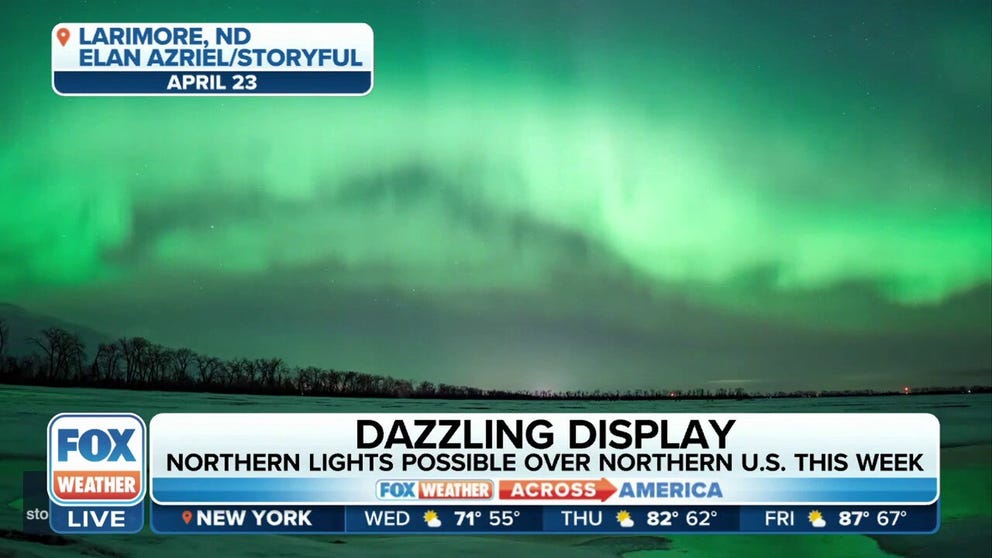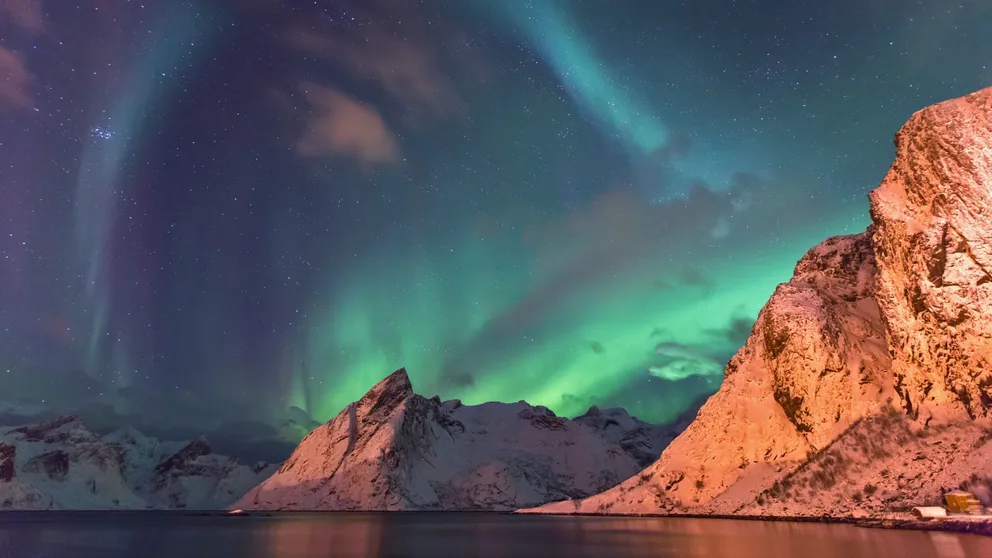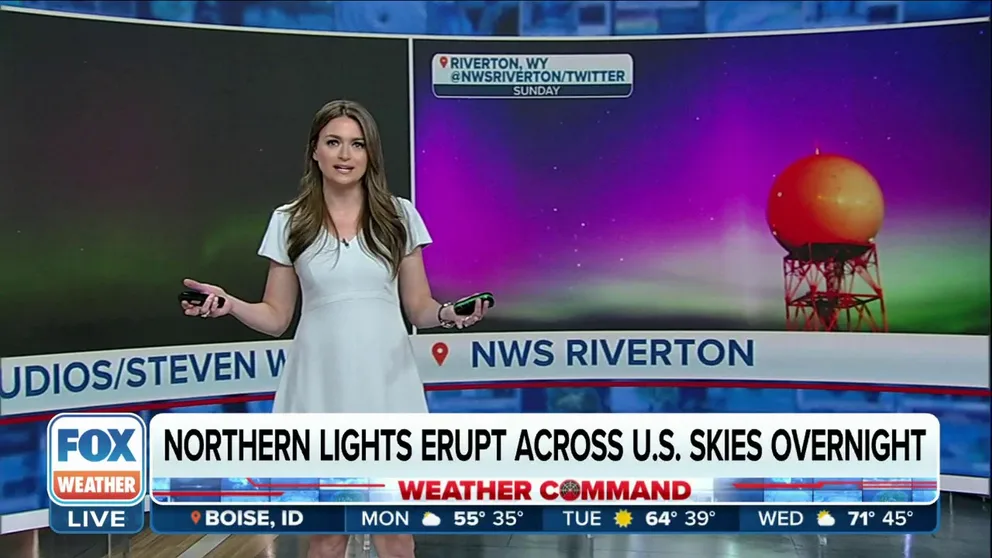Northern lights could be seen farther south this week as Geomagnetic Storm Watch issued
According to NOAA's Space Weather Prediction Center (SWPC), a pair of coronal mass ejections (CMEs) from the sun have been observed this week – one on Sunday and another on Tuesday.
Northern lights are possible for many Americans across the northern US this week
Hayden Planetarium Astronomer Joe Rao joins FOX Weather to discuss how a powerful sun storm will cause multiple states across the United Staes to see northern lights.
Space weather is happening all the time, but if you are lucky enough this week, you might catch a glimpse of the aurora borealis over the Northern Hemisphere.
According to NOAA's Space Weather Prediction Center (SWPC), a pair of coronal mass ejections (CMEs) from the sun have been observed this week – one on Sunday and another on Tuesday.
A Geomagnetic Storm Watch has been issued for Thursday. This comes after the first CME peaked Wednesday, creating a G2-level (moderate) storm out of a possible 5 levels on the scale. The second flare is forecast to arrive on Thursday and create a G3-level (strong) storm.
The northern lights are primarily seen in the higher latitudes in Alaska or Canada, but they have also been seen farther south in California, Nevada and even Texas during significant solar events.
This event is expected to be much weaker than the severe geomagnetic events that happened in late April and March.
WATCH OUT FOR THESE ASTRONOMICAL EVENTS IN 2023
If strong enough, space weather events could have significant impacts on power grids, aviation, satellites and oil and gas industries, said Lt. Bryan Brasher, a project manager with the SWPC.
The agency is on watch 24/7, observing and forecasting the space weather environment to allow these key parts of Earth's infrastructure to take mitigating actions to protect their equipment and services.
7 THINGS TO KNOW ABOUT THE NORTHERN LIGHTS
What is an aurora? The northern lights explained
Dancing across the skies in vibrant ribbons of color, auroras are one of nature’s most magnificent natural phenomena.
Will I see the aurora tonight?
The aurora can often be observed somewhere on Earth from just after sunset to just before sunrise.
The map below from the SWPC shows a prediction of the intensity and location of the aurora borealis Thursday night and Friday night over North America. It also shows a viewline that represents the southern-most locations from which you may see the aurora on the northern horizon.
The SWPC said the brightness and location of the aurora is typically shown as a green oval centered on Earth’s magnetic pole. The green ovals turn red when the aurora is forecasted to be more intense.
THESE ARE THE 5 CATEGORIES THAT MEASURE GEOMAGNETIC STORMS
The more overhead the aurora, the more likely it'll be visibile.
"Based on the fact that aurora typically occur up to 250 miles above the surface of the Earth, it should be possible with the curvature of the Earth (with no light pollution and marginal cloud cover) to see the aurora low on the northern horizon up to 800 to 1,000 miles away," Brasher said.
However, in areas of even moderate light pollution, seeing the aurora might only be possible through long-exposure images, Brasher added.
"Long exposure may also make aurorae visible south of the 800- to 1,000-mile boundary," Brasher continued. "When you are that far south, you may only see the reddish 'tops' of the aurorae (vs. the characteristic green bands visible in the pictures we've all seen taken from above the Arctic Circle)."
WATCH: LUCKY PASSENGER CAPTURES STUNNING TIME-LAPSE VIDEO OF NORTHERN LIGHTS FROM PLANE WINDOW
Northern Lights erupt across the US skies, seen as far south as Arizona
People across the U.S. were treated to a spectacular light show Sunday night, as a solar storm brought a vibrant display of aurora, also known as the Northern Lights, to over two dozen states. They were seen as far south as Phoenix, Arizona.
As of Thursday morning, there were no Geomagnetic Warnings in effect.
"We do have a couple of recent alerts and warnings related to other space weather phenomena that mainly affect radio communication," Brasher said.
A watch is issued when it's believed there will be a risk of significant space weather, but the occurrence or timing is uncertain. A warning is issued when space weather is occurring, imminent or extremely likely based on model data or observation-derived calculations. An alert is issued when a space weather event has already started.
Space weather happens all the time
We've had two G4 storms in the last few months, and we will likely see more soon, according to Brasher.
So while even if Wednesday's storm isn't big, Brasher said you can expect with a high level of certainty that we will have a few more before this solar cycle is done. However, to see the aurora in New York, for example, Brasher said a G3 or greater storm is required.
Yet if you live in the city or suburbs, Brasher said you aren't likely going to be dark enough to see the aurora. If you know a storm is coming, go north while getting as far away from city lights as possible and avoiding cloud cover.
Historical data shows that one could expect about 60 G4-level storms and four G5-level storms per 11-year solar cycle.
"This is, of course, an average, but G5 storms are quite rare," Brasher said. "The last solar cycle was rather mild, but solar cycle 25 is already on its way to being much more active."
According to Brasher, space weather is intimately tied to activity on the sun. Activity on the sun goes through 11-year cycles during which the magnetic field goes from being very uniform to very tangled and chaotic, then back to uniform after the magnetic field of the sun flips.
"Sunspots and, therefore, solar activity is greatest when the magnetic fields are all tangled and chaotic, and we expect to hit peak activity sometime in the next few years," Brasher said.




